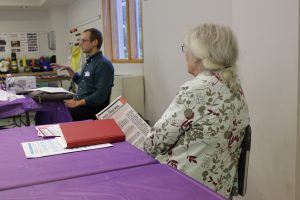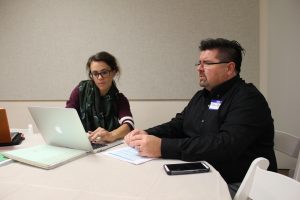Has it already been a year since our first Artist Studio Archives workshop? Believe it or not, our second workshop, held at the Mint Museum in Charlotte, has come and gone. The experience was different this time around because a team, we’ve learned so much in the past year. Through our experiences at institutional archives and the time spent working closely with individual artists, I think we’ve all gained greater insight into the complexities and intricacies surrounding artists’ studio archives. We’ve attended conferences and discussed the project with professionals in varied fields, gathering valuable perspectives on the project and the workshops. All this new knowledge and deeper understanding was reflected in the content and format of our second workshop, presented to an entirely new set of artists, all with their own unique needs and interests.
This year we added two new sessions to the program. “Copyright: the Good, the Bad, and the Ugly” dealt with issues of copyright and fair use. Elizabeth, Denise, and I discussed topics such as fair use and licensing. Elizabeth’s experience with how the Georgia O’Keeffe Foundation handles the use of her art provided valuable insight into legal methods of legacy protection. Erin, Carol, and Fannie held a session titled “Optimizing Archives: Grants, Exhibitions, and Marketing.” This session was popular and well attended, addressing topics that everyone could benefit from.
During lunch, several of our archivists had been unable to make it due to the weather, so Colin joined the panel along with Denise, and Joyce Weaver, current archivist at the Mint. They addressed questions on topics such as how an artist might approach an institution and what happens to collections once they are accepted. Colin’s project with artist Cornelio Campos sparked a lot of interest as an example of how this relationship can be mutually beneficial.
Another new addition to the workshop schedule this year was scheduled one-on-one discussions between the team and the artists. This proved as fruitful as we hoped. Because we cover a lot of information in a short amount of time in the breakout sessions it’s hard to fully address individual concerns. The one-on-one sessions allowed time to have those in-depth conversations. For example, artist Stacy C. Bottoms (website) talked with our resident preservation-of-social-media expert, Kim, about the best way to back up his website and blog. My conversation with artist Mi-Sook Hur (website) challenged me to think about a new problem. We were discussing the benefits of social media platforms for artists, (she mentioned the increased traffic her website received after an image of her work became popular Pinterest) and she noted that while she is intrigued by the possibilities, the time it would take to skillfully manage these types of self-promotion must be balanced with time spent with more traditional formats. She pointed out that museums often ask her to send images of her work on CD and simply directing them to her online portfolio or sending a digital file is not acceptable. She feels stuck between two worlds, wanting to spend her time on learning innovative ways to reach new audiences, but constrained by the traditional, perhaps outdated, practices of the museum world. While I didn’t have any easy answers for her, it started me thinking about the artists’ sometimes awkward position and what we could offer them.
There is much to mull over and still much to learn as we move toward the next step of the initiative. We’ll continue to work with our individual artists, present at various conferences and play with new ideas. These workshops have been successful enough that many other institutions and individuals have shown interest in hosting similar events for their local artists. The time we spend with both the information and artist communities bring us clarity of purpose, reveals the significance of this work, and encourages us to continue bringing energy and enthusiasm to this initiative.



